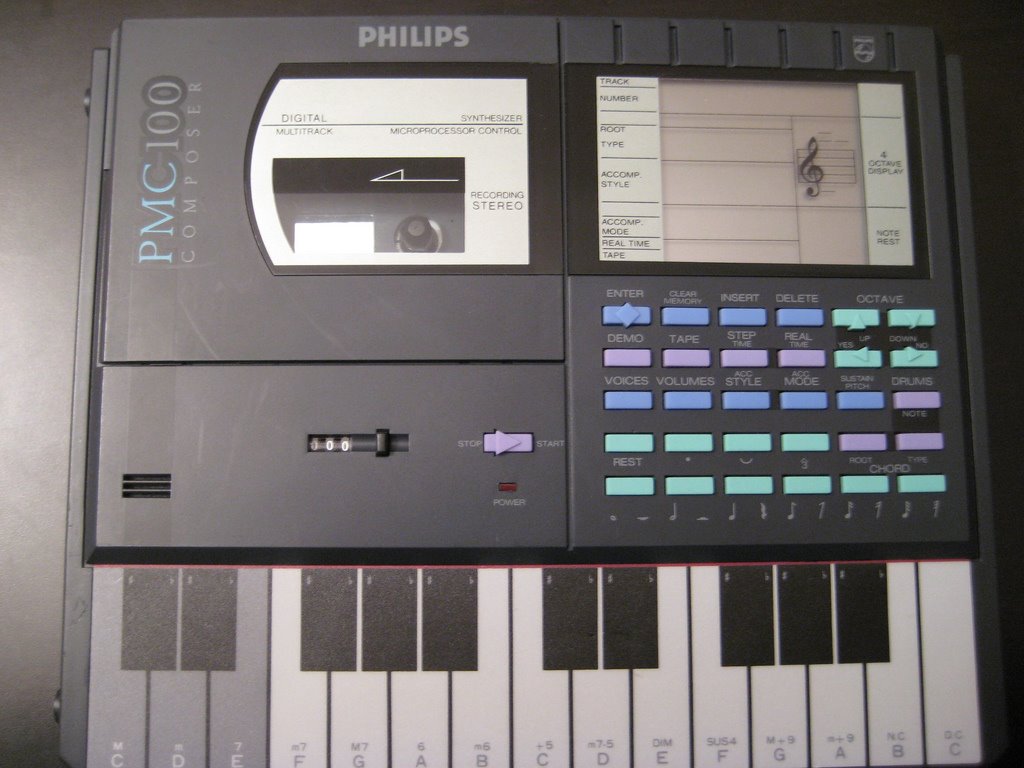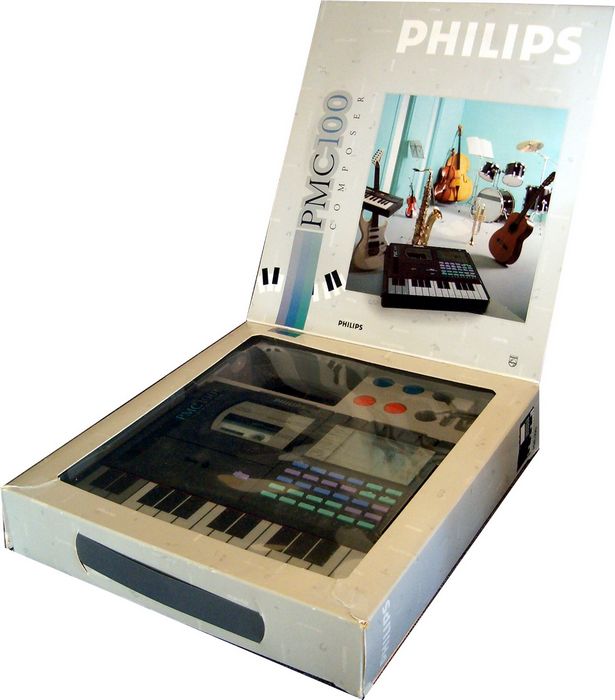Filter on ALL, SYNTH, DRUM, SAMPLER or MISC |
Total list currently 2405 items in 330 Brands |
Philips | PMC 100 |
Description | From the designer of the SFX peripherals for the Commodore 64, came this curious little box — the Personal Media Composer (PMC) 100. It's got a Yamaha two-operator FM chip, a membrane keyboard (flat, but not capacitive like the EDP Wasp) and its most striking feature, the built-in cassette deck. This allowed you to save your compositions as either sound or data, or it could function as a Walkman or dictaphone. The PMC 100 came in black or (a much rarer) white. The main voice is monophonic, with simple preset accompaniment rhythms (with 15 options for the rhythm's voice) controlled by the 'Gling' safe-note system. This heavily limits its potential as a solo instrument, not only because the beats are laughably thin but because the accompanying voices are fixed in their patterns. There are 100 preset melody voices, mostly the standard Yamaha PortaSound two-op noises, but there's also a surprising amount of useable sound effects and slow, evolving (but moving in very obvious digital steps) pads. It's charming in its own incredibly lo-fi way. The real area where it shines, though, is the step sequencer. It's visualized on an LCD screen in full stave notation with rock-steady tempo, adjustable to insane degrees! Notes can be edited in or out of the sequence at will. If this thing had MIDI out it would have become a cult classic. Sadly, though, it was a flop in terms of sales. It's not that hard to understand why; even by the mid-eighties this thing would have been considered comical and there's little hope of understanding the architecture without a manual. Still, it's a great curio to have in any synth collection and can even be useful for some styles or when buried in a mix. |
| Brand | Philips |
| Model | PMC 100 |
| Device | Synth |
| Type | Desktop |
| Engine Type | Digital |
| Engine | FM |
| Voices (max) | 1 |
| Oscillators | 2 |
| LFO | Preset operator modulation |
| Engine Detailed | 2 op FM, 100 preset main waveforms |
| Envelope (VCA) | Preset volume envelope |
| Memory | One internal sequence / cassette data storage |
| Sequencer | Complex programmable sequencer. 13 accompaniment rhythms, each with one of four accompaniment voice patterns |
| Recording | 3 Demo tracks |
| Keys | 25 |
| Key type | Membrame buttons |
| Velocity | N |
| Aftertouch | N |
| Produced: | 1986 - 1988 |
| Legend: | Obvious | Y: Yes, N: No, N/A: Not Applicable | |
| VCO | Voltage Controlled Oscillator | DCO | Digital Controlled Oscillator |
| LFO | Low Frequency Oscillator | Sub | Sub Oscillator |
| VCF | Voltage Controlled Filter | VCA | Voltage Controlled Amplifier |
| Velocity | As with a piano, the harder you hit a key, the louder the sound, unlike most organs which always produce the same loudness no matter how hard you hit a key. | Aftertouch | Pressing a key after you activated it. Channel Aftertouch, no matter which key, it will send a Channel message. Poly Aftertouch, sends the pressure per key instead of the whole channel. |
| Values for OSC, LFO, Filter, Envelope are per voice unless stated otherwise. | |||




